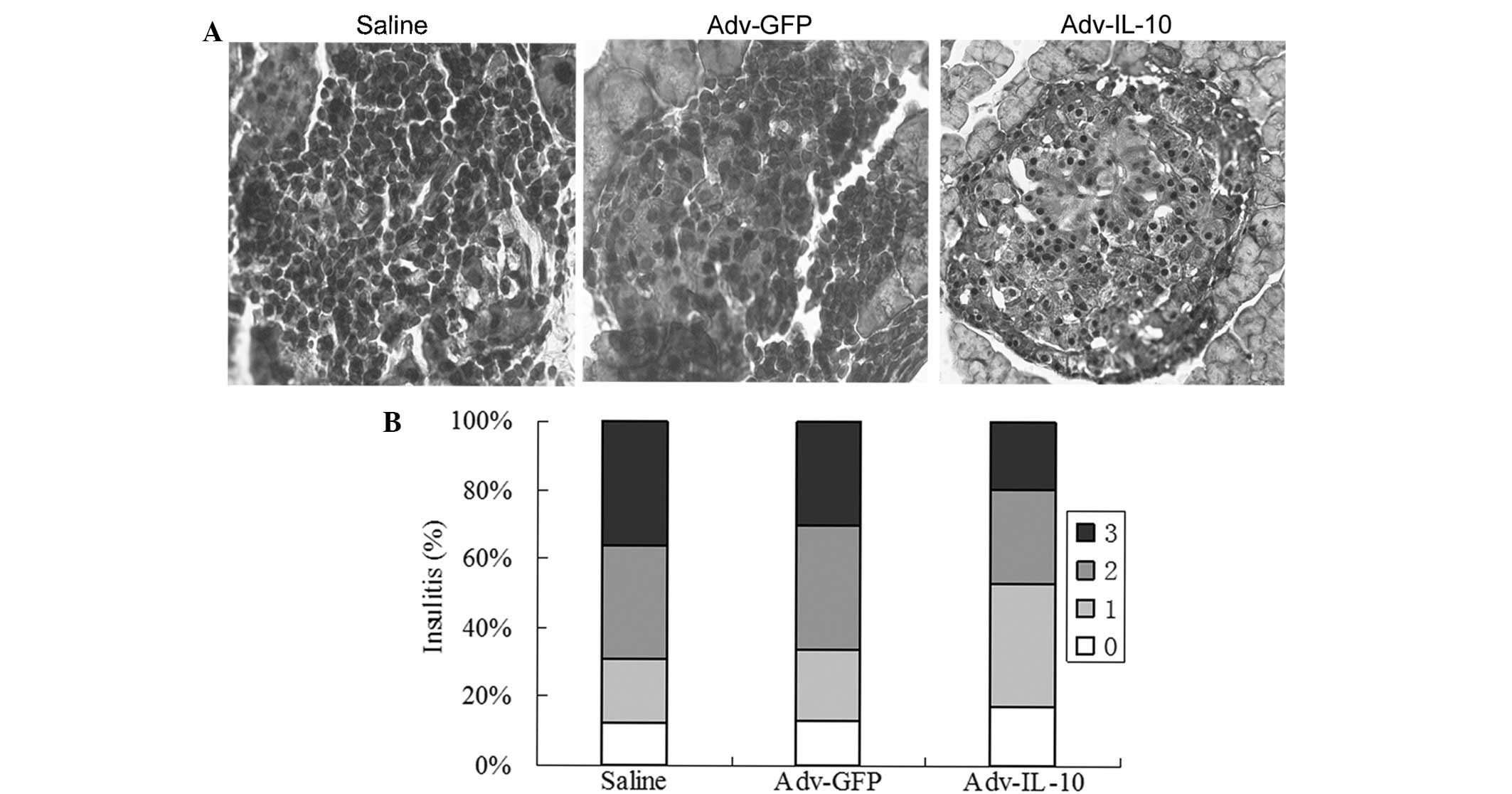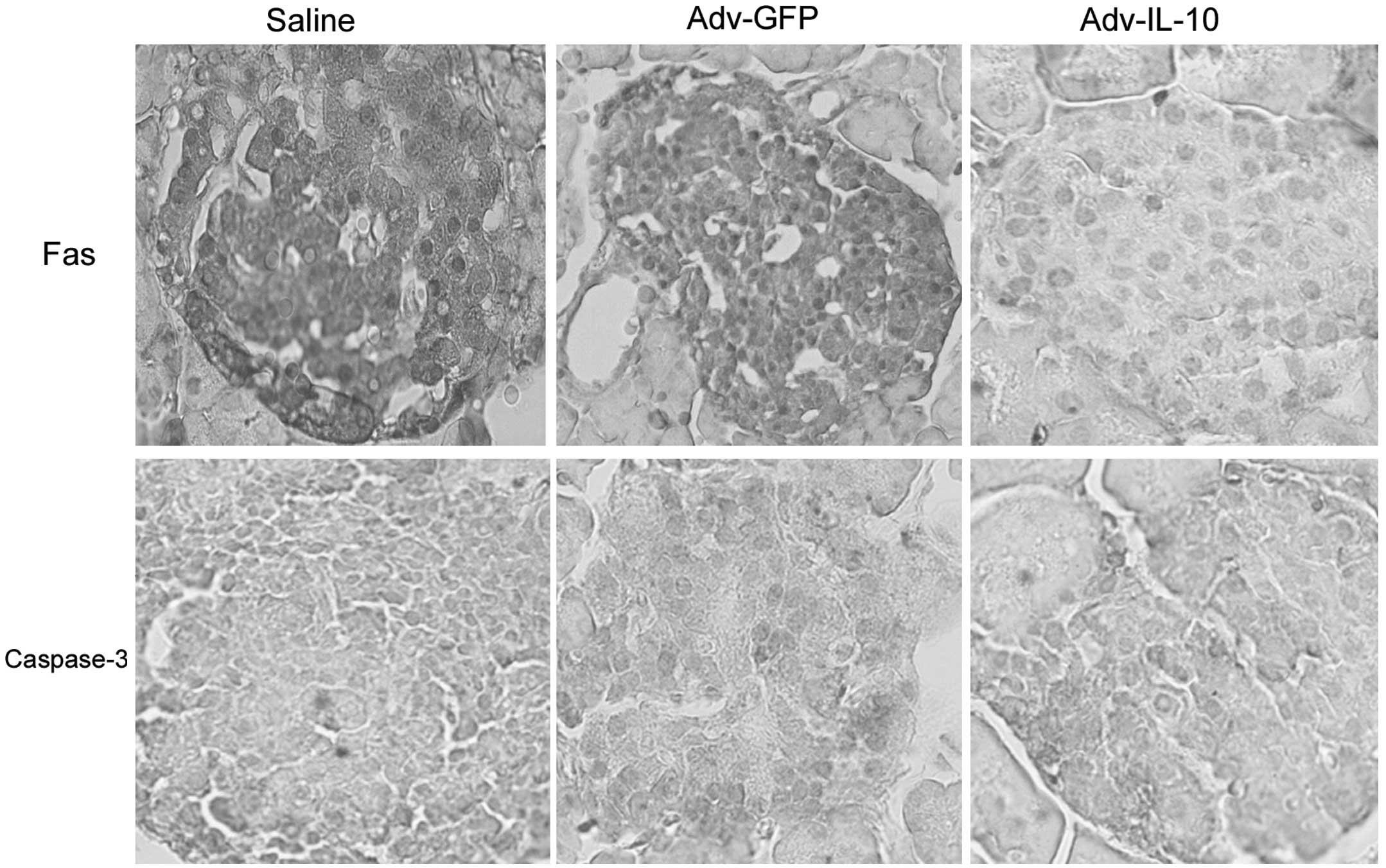|
1
|
Bekris LM, Kavanagh TJ and Lernmark A:
Targeting type 1 diabetes before and at the clinical onset of
disease. Endocr Metab Immune Disord Drug Targets. 6:103–124. 2006.
View Article : Google Scholar : PubMed/NCBI
|
|
2
|
Karlsson FA, Berne C, Björk E, et al:
Beta-cell activity and destruction in type 1 diabetes. Ups J Med
Sci. 105:85–95. 2000.PubMed/NCBI
|
|
3
|
Wilson SB, Kent SC, Patton KT, et al:
Extreme Th1 bias of invariant Valpha24JalphaQ T cells in type 1
diabetes. Nature. 391:177–181. 1998. View
Article : Google Scholar : PubMed/NCBI
|
|
4
|
Rabinovitch A: Immunoregulatory and
cytokine imbalances in the pathogenesis of IDDM. Therapeutic
intervention by immunostimulation? Diabetes. 43:613–621. 1994.
View Article : Google Scholar : PubMed/NCBI
|
|
5
|
Tisch R and McDevitt H: Insulin-dependent
diabetes mellitus. Cell. 85:291–297. 1996. View Article : Google Scholar : PubMed/NCBI
|
|
6
|
Delovitch TL and Singh B: The nonobese
diabetic mouse as a model of autoimmune diabetes: immune
dysregulation gets the NOD. Immunity. 7:727–738. 1997. View Article : Google Scholar
|
|
7
|
Zhang YC, Pileggi A, Agarwal A, et al:
Adeno-associated virus-mediated IL-10 gene therapy inhibits
diabetes recurrence in syngeneic islet cell transplantation of NOD
mice. Diabetes. 52:708–716. 2003. View Article : Google Scholar : PubMed/NCBI
|
|
8
|
Saraiva M and O'Garra A: The regulation of
IL-10 production by immune cells. Nat Rev Immunol. 10:170–181.
2010. View
Article : Google Scholar : PubMed/NCBI
|
|
9
|
Moore KW, de Waal Malefyt R, Coffman RL,
et al: Interleukin-10 and the interleukin-10 receptor. Annu Rev
Immunol. 19:683–765. 2001. View Article : Google Scholar : PubMed/NCBI
|
|
10
|
Ding Y, Chen D, Tarcsafalvi A, et al:
Suppressor of cytokine signaling 1 inhibits IL-10-mediated immune
responses. J Immunol. 170:1383–1391. 2003. View Article : Google Scholar : PubMed/NCBI
|
|
11
|
Nitta Y, Tashiro F, Tokui M, et al:
Systemic delivery of interleukin 10 by intramuscular injection of
expression plasmid DNA prevents autoimmune diabetes in nonobese
diabetic mice. Hum Gene Ther. 9:1701–1707. 1998. View Article : Google Scholar : PubMed/NCBI
|
|
12
|
Yang Z, Chen M, Wu R, et al: Suppression
of autoimmune diabetes by viral IL-10 gene transfer. J Immunol.
168:6479–6485. 2002. View Article : Google Scholar : PubMed/NCBI
|
|
13
|
Groux H, O'Garra A, Bigler M, et al: A
CD4+ T-cell subset inhibits antigen-specific T-cell responses and
prevents colitis. Nature. 389:737–742. 1997. View Article : Google Scholar : PubMed/NCBI
|
|
14
|
Asseman C, Mauze S, Leach MW, Coffman RL
and Powrie F: An essential role for interleukin 10 in the function
of regulatory T cells that inhibit intestinal inflammation. J Exp
Med. 190:995–1004. 1999. View Article : Google Scholar : PubMed/NCBI
|
|
15
|
Levings MK, Sangregorio R, Galbiati F, et
al: IFN-alpha and IL-10 induce the differentiation of human type 1
T regulatory cells. J Immunol. 166:5530–5539. 2001. View Article : Google Scholar : PubMed/NCBI
|
|
16
|
Goudy KS, Burkhardt BR, Wasserfall C, et
al: Systemic overexpression of IL-10 induces CD4+CD25+cell
populations in vivo and ameliorates type 1 diabetes in nonobese
diabetic mice in a dose-dependent fashion. J Immunol.
171:2270–2278. 2003. View Article : Google Scholar : PubMed/NCBI
|
|
17
|
Xu AJ, Chen ZH, Tian F, Yan LH and Li T:
Effects of adenovirus-mediated interleukin-10 gene transfer on
apoptosis and insulin secretion function of beta cell. Chinese
Medical Journal. 90:1711–1715. 2010.In Chinese.
|
|
18
|
Xu AJ, Zhu W, Tian F, Yan LH and Li T:
Recombinant adenoviral expression of IL-10 protects beta cell from
impairment induced by pro-inflammatory cytokine. Mol Cell Biochem.
344:163–171. 2010. View Article : Google Scholar : PubMed/NCBI
|
|
19
|
Marselli L, Dotta F, Piro S, et al: Th2
cytokines have a partial, direct protective effect on the function
and survival of isolated human islets exposed to combined
proinflammatory and Th1 cytokines. J Clin Endocrinol Metab.
86:4974–4978. 2001. View Article : Google Scholar : PubMed/NCBI
|
|
20
|
Casellas A, Salavert A, Agudo J, et al:
Expression of IGF-I in pancreatic islets prevents lymphocytic
infiltration and protects mice from type 1 diabetes. Diabetes.
55:3246–3255. 2006. View Article : Google Scholar : PubMed/NCBI
|
|
21
|
van Belle TL, Coppieters KT and von
Herrath MG: Type 1 diabetes: Etiology, immunology, and therapeutic
strategies. Physiol Rev. 91:79–118. 2011. View Article : Google Scholar : PubMed/NCBI
|
|
22
|
Thomas HE, Graham KL, Chee J, et al:
Proinflammatory cytokines contribute to development and function of
regulatory T cells in type 1 diabetes. Ann NY Acad Sci. 1283:81–86.
2013. View Article : Google Scholar
|
|
23
|
Serreze DV, Chapman HD, Post CM, et al:
Th1 to Th2 cytokine shifts in nonobese diabetic mice: sometimes an
outcome, rather than the cause, of diabetes resistance elicited by
immunostimulation. J Immunol. 166:1352–1359. 2001. View Article : Google Scholar : PubMed/NCBI
|
|
24
|
Asadullah K, Sterry W and Volk HD:
Interleukin-10 therapy – review of a new approach. Pharmacol Rev.
55:241–269. 2003. View Article : Google Scholar : PubMed/NCBI
|
|
25
|
Pennline KJ, Roque-Gaffney E and Monahan
M: Recombinant human IL-10 prevents the onset of diabetes in the
nonobese diabetic mouse. Clin Immunol Immunopathol. 71:169–175.
1994. View Article : Google Scholar : PubMed/NCBI
|
|
26
|
Goudy K, Song S, Wasserfall C, et al:
Adeno-associated virus vector-mediated IL-10 gene delivery prevents
type 1 diabetes in NOD mice. Proc Natl Acad Sci USA.
98:13913–13918. 2001. View Article : Google Scholar : PubMed/NCBI
|
|
27
|
Suk K, Kim S, Kim YH, et al:
IFN-gamma/TNF-alpha synergism as the final effector in autoimmune
diabetes: a key role for STAT1/IFN regulatory factor-1 pathway in
pancreatic beta cell death. J Immunol. 166:4481–4489. 2001.
View Article : Google Scholar : PubMed/NCBI
|
|
28
|
Tang Q, Henriksen KJ, Boden EK, et al:
Cutting edge: CD28 controls peripheral homeostasis of CD4+CD25+
regulatory T cells. J Immunol. 171:3348–3352. 2003. View Article : Google Scholar : PubMed/NCBI
|
|
29
|
Chen Z, Herman AE, Matos M, Mathis D and
Benoist C: Where CD4+CD25+ Treg cells impinge on autoimmune
diabetes. J Exp Med. 202:1387–1397. 2005. View Article : Google Scholar : PubMed/NCBI
|
|
30
|
Feuerer M, Shen Y, Littman DR, Benoist C
and Mathis D: How punctual ablation of regulatory T cells unleashes
an autoimmune lesion within the pancreatic islets. Immunity.
31:654–664. 2009. View Article : Google Scholar : PubMed/NCBI
|
|
31
|
Herman AE, Freeman GJ, Mathis D and
Benoist C: CD4+CD25+ T regulatory cells dependent on ICOS promote
regulation of effector cells in the prediabetic lesion. J Exp Med.
199:1479–1489. 2004. View Article : Google Scholar : PubMed/NCBI
|
|
32
|
Gregori S, Giarratana N, Smiroldo S and
Adorini L: Dynamics of pathogenic and suppressor T cells in
autoimmune diabetes development. J Immunol. 171:4040–4047. 2003.
View Article : Google Scholar : PubMed/NCBI
|
|
33
|
Salomon B, Lenschow DJ, Rhee L, et al:
B7/CD28 costimulation is essential for the homeostasis of the
CD4+CD25+ immunoregulatory T cells that control autoimmune
diabetes. Immunity. 12:431–440. 2000. View Article : Google Scholar : PubMed/NCBI
|
|
34
|
Walker LS: Natural Treg in autoimmune
diabetes: all present and correct? Expert Opin Biol Ther.
8:1691–1703. 2008. View Article : Google Scholar : PubMed/NCBI
|
|
35
|
Szanya V, Ermann J, Taylor C, Holness C
and Fathman CG: The subpopulation of CD4+CD25+ splenocytes that
delays adoptive transfer of diabetes expresses L-selectin and high
levels of CCR7. J Immunol. 169:2461–2465. 2002. View Article : Google Scholar : PubMed/NCBI
|
|
36
|
Kay TW, Thomas HE, Harrison LC and Allison
J: The beta cell in autoimmune diabetes: many mechanisms and
pathways of loss. Trends Endocrinol Metab. 11:11–15. 2000.
View Article : Google Scholar : PubMed/NCBI
|
|
37
|
Cnop M, Welsh N, Jonas JC, et al:
Mechanisms of pancreatic beta-cell death in type 1 and type 2
diabetes: many differences, few similarities. Diabetes. 54(Suppl
2): S97–S107. 2005. View Article : Google Scholar : PubMed/NCBI
|
|
38
|
Katz JD, Benoist C and Mathis D: T helper
cell subsets in insulin-dependent diabetes. Science. 268:185–1188.
1995. View Article : Google Scholar
|
|
39
|
Kurrer MO, Pakala SV, Hanson HL and Katz
JD: Beta cell apoptosis in T cell-mediated autoimmune diabetes.
Proc Natl Acad Sci USA. 94:213–218. 1997. View Article : Google Scholar : PubMed/NCBI
|
|
40
|
Kim YH, Kim S, Kim KA, et al: Apoptosis of
pancreatic beta-cells detected in accelerated diabetes of NOD mice:
no role of Fas-Fas ligand interaction in autoimmune diabetes. Eur J
Immunol. 29:455–465. 1999. View Article : Google Scholar : PubMed/NCBI
|
|
41
|
Eizirik DL and Mandrup-Poulsen T: A choice
of death – the signal-transduction of immune-mediated beta-cell
apoptosis. Diabetologia. 44:2115–2133. 2001. View Article : Google Scholar
|
|
42
|
Slee EA, Adrain C and Martin SJ: Serial
killers: ordering caspase activation events in apoptosis. Cell
Death Differ. 6:1067–1074. 1999. View Article : Google Scholar : PubMed/NCBI
|
|
43
|
Wolf BB, Schuler M, Echeverri F and Green
DR: Caspase-3 is the primary activator of apoptotic DNA
fragmentation via DNA fragmentation factor-45/inhibitor of
caspase-activated DNase inactivation. J Biol Chem. 274:30651–30656.
1999. View Article : Google Scholar : PubMed/NCBI
|
|
44
|
Loweth AC, Williams GT, James RF,
Scarpello JH and Morgan NG: Human islets of Langerhans express Fas
ligand and undergo apoptosis in response to interleukin-1beta and
Fas ligation. Diabetes. 47:727–732. 1998. View Article : Google Scholar : PubMed/NCBI
|
|
45
|
Riachy R, Vandewalle B, Moerman E, et al:
1, 25-Dihydroxyvitamin D3 protects human pancreatic islets against
cytokine-induced apoptosis via down-regulation of the Fas receptor.
Apoptosis. 11:151–159. 2006. View Article : Google Scholar : PubMed/NCBI
|
|
46
|
Zhou JH, Broussard SR, Strle K, et al:
IL-10 inhibits apoptosis of promyeloid cells by activating insulin
receptor substrate-2 and phosphatidylinositol 3′-kinase. J Immunol.
167:4436–4442. 2001. View Article : Google Scholar : PubMed/NCBI
|
|
47
|
Dhingra S, Sharma AK, Arora RC, Slezak J
and Singal PK: IL-10 attenuates TNF-alpha-induced NF kappaB pathway
activation and cardiomyocyte apoptosis. Cardiovasc Res. 82:59–66.
2009. View Article : Google Scholar : PubMed/NCBI
|
|
48
|
Londoño D, Carvajal J, Strle K, Kim KS and
Cadavid D: IL-10 Prevents apoptosis of brain endothelium during
bacteremia. J Immunol. 186:7176–7186. 2011. View Article : Google Scholar : PubMed/NCBI
|
|
49
|
Bharhani MS, Borojevic R, Basak S, et al:
IL-10 protects mouse intestinal epithelial cells from Fas-induced
apoptosis via modulating Fas expression and altering caspase-8 and
FLIP expression. Am J Physiol Gastrointest Liver Physiol.
291:G820–G829. 2006. View Article : Google Scholar : PubMed/NCBI
|















